
|
Special Effects (F/X) - Milestones in Film 2006-2007 |
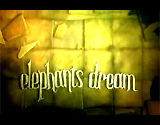
|
Elephants Dream (2006) (short) This computer-generated (or CGI) experimental short film (10 minutes in length), a dramatic fantasy, was made primarily using open source applications, and the first to be released as 'open source.' It marked a major milestone in open source CG animation production. It was the first CG animated short made in a team-based environment that was produced almost completely with free tools, available to anyone. This meant that all 3D modeling, animation, and rendering using the 3D suite of Blender software was free for anyone's use. It was a test film, to demonstrate the use of the software, and had only two characters, who were exploring a dreamlike, strange and infinitely-large machine:
|
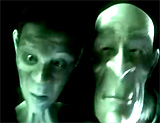 (l to r): Emo and Proog 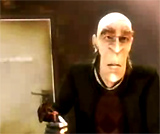
|
||||||
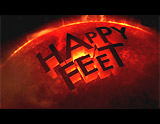
|
Happy Feet (2006, Australia/US)
It told about a tone-deaf baby penguin Mumble (voice of Elizabeth Dailey as baby), who did not have a heartsong (to attract a mate) and was treated like an outcast. But he did have an amazing dancing talent. Extensive motion capture of live-action humans (to provide their digitally-recorded movements) was used in Mumble's dance sequences:
The hoofer wore a black bodysuit with 40 reflective sensors near his joints, to record his movements (as data) from the light reflectors - which were then turned into the bird's final performance by five motion editors and ten computer animators. However, all of the humans in the film were live-action, not CGI. |
 Baby Mumble 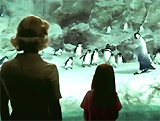 Mumble Dancing For Human Zoo Visitors 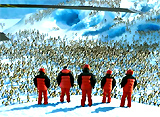 Arrival of "Aliens" - A Research Team 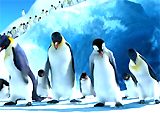 The Dance Finale |
||||||
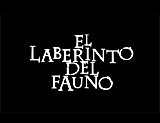
|
Pan's Labyrinth (2006, Sp./Mex./US) (aka El Laberinto del Fauno) This wondrously imaginative World War II era fantasy film was from director Guillermo del Toro. Its main Special F/X included animatronics (i.e., the giant toad in an old fig tree) and complex make-up. The mandrake root was a hybrid of animatronics and CGI. It was set in Spain during fascist Franco's regime, when young Ofelia (Ivana Baquero) was brought with her pregnant mother Carmen (Ariadna Gil) to live with her adoptive stepfather, malevolent and brutal Spanish fascist Captain Vidal (Sergi López). To escape the tough realities of wartime, Ofelia sought refuge in an imaginary escapist world in a forest home filled with fairies - and a menacing faun creature named Pan (Doug Jones), the guardian of the labyrinth. She also communicated with a stick bug-insect (CGI) that she believed was a fairy. The same contortionist/monster actor Doug Jones, again with an elaborate, heavy prosthetic makeup and costuming (requiring five hours of prep time), also portrayed the character of the faceless, vile, humanoid, all-devouring Pale Man, who enjoyed consuming live and defenseless children. He was noted for his pale, elastic skin.
He awoke from his slumber when Ofelia was disobedient, took his eyeballs from the table in front of him, and placed them into eye sockets in the palm of his two claw-like hands. This enabled him to see so that he could pursue and eat Ofelia. |
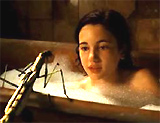 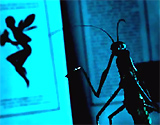 Ofelia's "Fairy" - CGI Stick-Bug 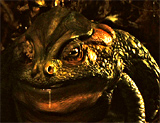 The Animatronic Giant Toad 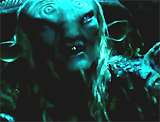 Pan, the Faun |
||||||
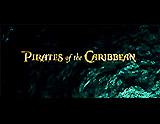 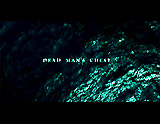
|
Pirates of the Caribbean: Dead Man's Chest (2006)
There were a total of 1,100 visual effects shots, and various techniques included digital matte paintings (digimattes), model miniatures (i.e., the Black Pearl ship), motion-capture and lots of CG (including digital doubles for the three lead actors, and a digital monkey). CGI imagery had reached the point of becoming so convincing that the completely computer-generated Captain Davy Jones (Bill Nighy), a monstrously Octopus-faced-and-tentacled villainous under-sea creature, was so realistic that some critics in their reviews mistakenly thought Nighy was wearing prosthetic makeup. In fact, although the actor wore a "motion capture" suit for the camera to provide a reference point, none of his real face remained in the final film - the animators even used CGI for Jones' eyes. Visual effects artists at ILM used an instant (or on-the-spot) motion-capture-to-CG process, and an inventive technique called sub-surface scattering (to believably mimic the look of semi-translucent skin) to create the effect.
For the Kraken attacks, compositors integrated CG water, practical water splashes, CG characters, CG mast and sail extensions, digital debris, and bluescreen actors into live action plates of a practical ship, real debris, smoke, water and mist. |
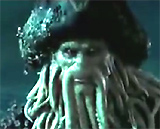 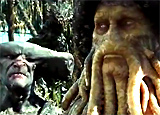 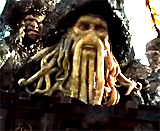 Captain Davy Jones - CG 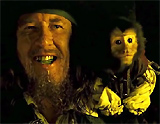 Digital Monkey Jack on Resurrected Pirate Hector Barbossa's (Geoffrey Rush) Shoulder |
||||||
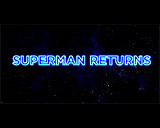
|
Director Bryan Singer's superhero sequel served as a follow-up to the first two Superman films of the late 1970s: There were a total of 1,400 visual effects shots in the film. In many cases, motion-captured photographs of actor Brandon Routh's face were applied to 3D digital models of the Superman character. In addition to photographing Routh's face, the crew motion-captured his body and facial expressions to help animators create the double's performance. In flying sequences, Routh 'flew' on wires rigged on a 100-foot long greenscreen stage. Often, a completely-realistic digital body double of Superman then replaced the green-screen footage in final shots - sometimes completely, but sometimes only partially. Superman's cape was usually digital. A digital city of Metropolis was created, as was a digital Daily Planet office and cars on the streets. The city of New York was the model for the mapping, but was then modified, with landmarks such as the Statue of Liberty and the Chrysler Building removed. The film used realistic, dramatic CGI, such as in the federal bank robbery scene of a slow-motion bullet from a hand-gun crushing itself against Superman's eyeball, after he blocked bullets with his chest (with an 'S' insignia) being fired from a gigantic rooftop machine gun toward two security guards. In one fantastical sequence, Superman safely lowered a Boeing 777 plane onto a baseball field, filled with digital extras. CG was also used in the recreation of the role of Superman's biological father Jor-El (Marlon Brando) in the Fortress of Solitude sequence in the film's opening. The FX team used archival film footage from the first two films along with CGI interpolation, modeling and animation to create a three-dimensional image while the character delivered new dialogue that existed previously only as vocal tracks. |
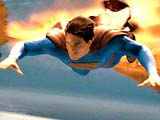 Digital Superman Cape  Plane Saved in Baseball Stadium 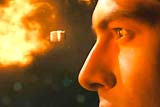  Slo-Mo CGI 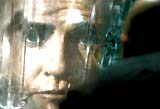 Post-Humous Recreated Digital Image of Marlon Brando |
||||||

|
300 (2006) The title of director Zack Snyder's very original, highly-stylized war drama (with elements of fantasy) referred to the 300 Spartans who fought to the death at the three-day Battle of Thermopylae. It was a major battle between the overwhelmed Greek forces led by King Leonidas (Gerard Butler), and the Persian forces of Xerxes (Rodrigo Santoro). The epic film was based on Frank Miller's 1998 comic book novel - and was a shot-by-shot adaptation of the comic-book panels. With three beheadings and lots of blood-letting (with 2-D blood), the film earned an R-rating. With a couple of minor exceptions, the entire film was shot indoors, against a blue screen. It was shot mostly with a super-imposition chroma key technique, to replicate the images of the original comic book. The film had a desaturated, sepia-toned, artistic look. The actors were filmed before blue-screens (and green-screens 10% of the time), upon which backgrounds were filled in later with more than 1,500 CG visual effects shots (comprising over 8,600 visual effects elements).
Animatronics were used for various animals (horses, a wolf, elephants, etc.). Although filming occurred for only 60 days (on a soundstage in Montreal), it took over a year in post-production to finish the film. |
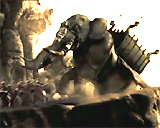 Animatronics Elephant 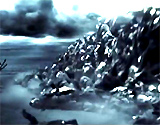 The Wall of Death  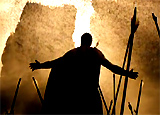 Thousands of Arrows |
||||||
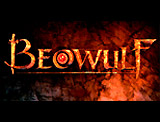
|
Beowulf (2007) This Robert Zemeckis-directed animated adventure, an adaptation of the Old English epic poem set in 6th century Denmark, used advanced motion-capture technology to transform live action into digital animation, resulting in a 100% CGI film. The performances of all of the actors playing the human characters in the film, including those in crowds, were captured and then all of that data was applied to the CG characters. Some called it the "next generation" of live action - or "digitally enhanced live action." The technique of motion capture was first used in Peter Jackson's The Lord of the Rings: The Two Towers (2002) for the character of Gollum (see above), and in Zemeckis' own The Polar Express (2004), although the movements were now much more realistic, fluid and natural. The $150 million budgeted-film was released simultaneously in 2-D and non-IMAX 3D (called REAL D) versions, and had the biggest 3-D rollout of any film in history - opening on almost 1,000 digital 3-D screens and in 90 IMAX theaters.
In one of the most memorable scenes, Grendel's murderous, sea-dwelling Mother (Angelina Jolie), a beautiful and slinky sea creature and the shape-shifting mother of mutated monster Grendel, rose up naked from the water. She had a long tail and wore stilettos. She was seen covered with dripping gold liquid (although virtual and 100% CGI as a digital replica), and looking like a golden Academy Award Oscar statue. A gold-painted, CGI nude body (modeled after blonde bikini and lingerie model Rachel Bernstein) was attached to Angelina Jolie's CGI-rendered head. Her words were very enticing to buffed-up warrior Beowulf (Ray Winstone), and she completely disarmed him:
In another sequence in the film, Beowulf fought against Grendel (Crispin Glover) stark naked (without any weapons or armor), and the animators had to devise ways to hide his genitals from clear view during their battle - similar to Austin Powers: International Man of Mystery (1997), or the censored version of Kubrick's Eyes Wide Shut (1999). |
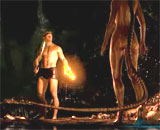 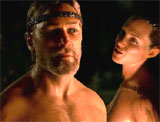 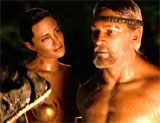 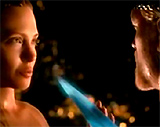 Seductive Grendel's Mother Offer to Beowulf 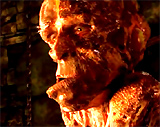 Grendel 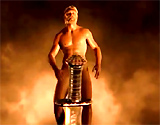 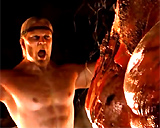 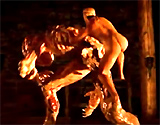 Beowulf vs. Grendel |
||||||
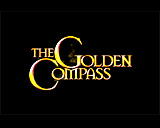
|
The Golden Compass (2007)
Writer/director Chris Weitz's fantasy film (a combination of live-action and CG) was based on the first book in Philip Pullman's "His Dark Materials" trilogy. It starred Nicole Kidman and Daniel Craig, and told about the journey of 12 year-old orphan Lyra Belacqua (Dakota Blue Richards) to rescue kidnapped friend Roger (Ben Walker) from the Magisterium. The film had some of the most complicated or complex effects sequences ever seen. It required nearly two years to complete and more than 500 F/X artists in three countries. There were close to 1,200 CGI shots, and complex animal characters appeared in almost every scene, often interacting with live-action human characters. Remarkable CGI-imagery was employed in the representation of people's souls - a daemon visualized as an animal companion. The daemon creatures were computer-created and animated, and incorporated into about 800 camera shots in the film. Shooting was accomplished on green-screen soundstages where the actors held and acted with a variety of objects that would be replaced by CG daemons. The most prominent daemons were Lyra's shape-shifting Pantalaimon (aka Pan) (voice of Freddie Highmore) - at times a ferret (or ermine), a wood mouse, a cobra, a striped wildcat, a moth, or a bird. There was also the Golden Monkey daemon of villainess Mrs. Coulter (Nicole Kidman), and Stelmaria, the snow leopard daemon for Lyra's uncle, explorer Lord Asriel (Daniel Craig). An evil authority known as the Magisterium was attempting to separate the paired-up daemons, thus eliminating free-will. In addition, mystical Dust particles in the universe (representing intelligence) were visualized with fluid simulations. When a person was killed (especially in the film's climactic Battle of Bolvangar sequence involving flying witches, an attacking ice-bear, fleeing children, and Samoyeds), a daemon's dust particles disintegrated in a fiery sparkling cloud. Another phenomenal sequence was the realistic, totally CGI ice-bear fight - a monumental single-combat, vicious fight-to-the-death between two ice-bears or Panserbjorne (while over 100 other bears looked on) - with authentic looking polar-bear fur, muscles, paws, and flying ice:
|
 CGI Daemon Golden Monkey 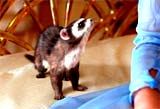 CGI Pan - a Ferret 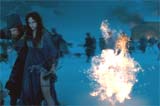 Dust Particles 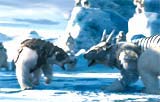
CGI Ice-Bear Fight |
||||||
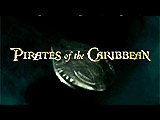 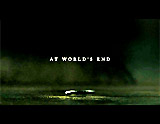
|
Pirates of the Caribbean: At World's End (2007) The film was nominated for an Academy Award for Best Visual Effects, but lost to The Golden Compass (2007). There were about 2,000 visual effects shots in the pirate swashbuckler second sequel. In this third film in the franchise, Captain Jack Sparrow (Johnny Depp) was eternally imprisoned at World's End in Davy Jones' Locker. There in the afterlife, Captain Jack was stranded with his pirate ship The Black Pearl in the middle of a desert, and was suffering from schizophrenic-like, multiple hallucinations of himself, created with multiple pass technology. There were also miniature versions of Jack talking while dangling from his dreadlocks of hair. Other parts of the film recognized for visual effects achievements were:
|
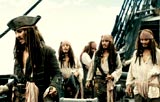   Multiple Captain Jacks 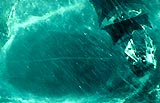 Whirlpool Battle Scene 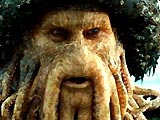 CGI Davy Jones |
||||||
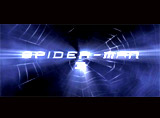
|
This was the third in the series of superhero films featuring Marvel Comics' Spider-Man, from director Sam Raimi, with a record 900 visual effects shots in the film. It took three years to create and pack the film with visual effects, and was one of the most expensive films of all time, with a budget of $258 million. Spidey’s latest three new villains were the Harry Osborn/the New Goblin (James Franco), Flint Marko/Sandman and Eddie Brock/Venom (Topher Grace). Teams of F/X artists worked for more than two years to develop techniques for creating the CG characters of Sandman and Venom. The most impressive visual FX sequences involved the Sandman's shape-shifting powers, such as:
Other spectacular shots were:
There were many other great action scenes, such as:
|
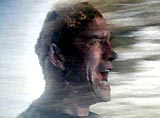 Freak Accident 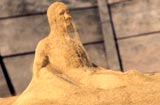 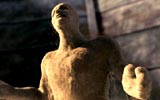 Birth of Sandman 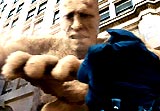 Giant Sandman 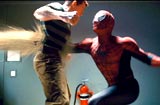 Digitally-Enhanced Punch in Chest 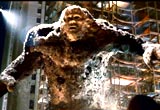 Giant Sandman |
||||||
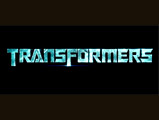
|
Transformers (2007) Director Michael Bay insisted that the CGI (containing some of the most complex animations possible from ILM) for his robot-related live-action film was to be restricted to the robots and some background elements in the action sequences. In total, there were 60,217 vehicle parts and over 12.5 million polygons assembled into 14 giant, shape-changing automatons (each composed of thousands of moving pieces). For example, the heroic autobot commander Optimus Prime that ILM created for the film was elaborately detailed and gigantic - it had 10,108 parts and was 28 feet tall. He introduced himself to Sam Witwicky (Shia LaBeouf):
ILM created about three-fourths of the special FX (450 shots), composed of intricate transformations of the 30 foot tall robots as they moved, and thousands of texture maps filled in additional details to the parts. Lengthy renderings were required to complete only one frame of movement. And to make the robots more realistic, ray-tracing (reflections of the surrounding environment on surfaces) was also used. |
 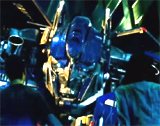 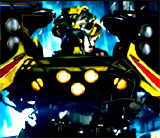
|
||||||